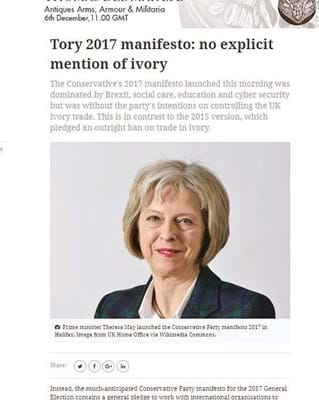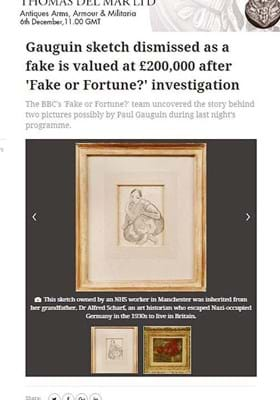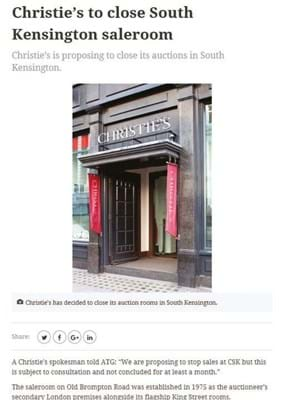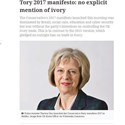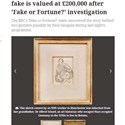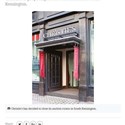What did you read in the past 12 months and how did you read it?
Here we reveal the year’s most-read stories on antiquestradegazette.com, ranked by the number of unique page views (that is, the amount of times a page is read by different people).
Of course, this list does not reflect the full variety and scope of the Gazette’s journalism – ATG journalists now produce 20,000 words a week in print, and an extra 1500 words a day online.
But the ranking is a good guide to what’s interesting for the ever-widening audience curious about our fascinating and colourful market.
ATG's most viewed web stories in 2017
1. Tory 2017 manifesto: no explicit mention of ivory
2. Christie’s to close South Kensington saleroom
3. Gauguin sketch dismissed as a fake is valued at £200,000 after 'Fake or Fortune?' investigation
4. A touch of the erotic: Collection of ‘Lolita’ publisher includes nudes by Schiele and Giacometti
5. Art and antiques industry reacts to impending closure of Christie’s South Kensington
6. Auction house Dreweatts and dealer Mallett under new owners
7. Video showing cleaning of an early 17th century painting at Philip Mould goes viral
8. Stamp dealer Stanley Gibbons’ investment arm goes into administration
9. Bolton saleroom offer convicted faker’s ‘Lowry’ imitations
10. Chinese sleeper at auction sets £810,000 house record for Fellows of Birmingham
Popular themes in 2017
• It’s no surprise, given the high profile of the UK ivory trade in 2017, that the snap general election in May led to ATG’s most viewed online story of the year.
This piece revealed that the Conservative Party’s 2017 manifesto included no explicit reference to a ban on ivory, contrasting with the 2015 version, which pledged an outright ban.
Meanwhile, Labour’s 2017 manifesto pledged, for the first time, to introduce a “total ban on ivory trading” if the party was elected.
ATG’s story on the manifestos got picked up in the political blogosphere and national media as the ivory debate gained wider attention.
• TV shows and ‘sleepers’ are two subjects that regularly generate extra traffic to ATG’s website. One story that combined both came in September when the BBC’s Fake or Fortune? team investigated two pictures believed by their owner to be by Paul Gauguin.
The team concluded that a still-life painting was not a Gauguin. However, a drawing of a Tahitian woman was deemed an early pencil sketch for his famous painting When Will you Marry?
Art dealer and Fake or Fortune? presenter Philip Mould valued it in excess of £200,000.
• Sex sells, right? In any publication’s ‘most read’ list, a story with the word ‘erotic’ in a headline tends to bump it up the leader board. This seems to have happened with our story about the collection of the late Lord Weidenfeld offered at Christie’s in May.
Had the same story been billed as ‘Single-owner auction features study of a female model by Egon Schiele’, we doubt it would have attracted the same amount of eyeballs.
• The trials and tribulations of Stanley Gibbons and its subsidiary firms, auction house Dreweatts and dealer Mallett, created a lot of attention this year, something keenly reflected in ATG’s web traffic: our sixth and eighth most popular news items in 2017 covered this story.
These articles created a noticeable boost in ATG’s web traffic while, unfortunately, Gibbons’ share price went in the opposite direction.
Easier access
ATG readers are increasingly relying on our website, e-bulletins and social media channels to find out what’s happening in the art market.
Aware that readers are often on the move – on buying trips, standing at fairs or bustling around their premises – we made strides to make the Gazette’s journalism more easily accessible, wherever readers happen to be or what devices they use.
Since April, the complete range of content from our weekly print edition has been available on the antiquestradegazette.com website as well as via our e-paper and app, all behind one convenient login.
Digital subscribers can now access the newspaper every Monday, with selected stories delivered via a new weekly e-bulletin highlighting the key pieces of content to read.
In June, the website was given a new look, complete with a grid-based layout to aid navigation.
The measures we took seem to chime with readers, with our number of unique users up by nearly half (48.2%) year-on-year.


